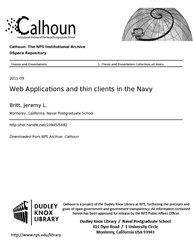File:Web Applications and thin clients in the Navy (IA webapplicationsn109455482).pdf

Original file (1,275 × 1,650 pixels, file size: 2 MB, MIME type: application/pdf, 110 pages)
Captions
Captions
Summary
[edit]| Web Applications and thin clients in the Navy
( |
||
|---|---|---|
| Author |
Britt, Jeremy L. |
|
| Title |
Web Applications and thin clients in the Navy |
|
| Publisher |
Monterey, California. Naval Postgraduate School |
|
| Description |
This thesis investigates the advantages and disadvantages of transitioning to Web Applications and Thin Client-Server Architecture for U.S. Navy shore based Components. Thin Clients and Web Technology have advanced significantly over the last few years and now more than ever, offer a multitude of cost efficient solutions. In the past, networking technology and bandwidth limitations made traditional Personal Computers or \"Fat Clients\" a more viable option for Naval Commands. The advancements in networking technology and Wi-Fi have significantly reduced these constraints. Moore's Law has held constant, advancing digital storage and processing capability far beyond the traditional Client-Server Architecture's ability to take full advantage of these services. The proliferation of server and network technology continues to provide economies of scale that drive down the cost of hardware. The accessibility of these technologies enabled application and software developers to steadily increase the size and complexity of software and applications. The Fat Client's proliferation led to most of this software and application development in the form of Native Applications. The cost of Software and Native Applications written for Fat Client platforms continues to increase while Server utilization remains negligible. Decentralization due to the inherent local access precipitated by the use of Fat Client-Server architectures and Native Applications creates surplus server capacity and redundant data centers. The The Navy's (DON) focus is shifting to Thin Clients and Enterprise Software Licensing due to budgetary constraints and the need for increased efficiencies. It is possible that Thin Client-Server Architecture and Web Applications may be able to provide these cost savings and efficiencies. Subjects: Client/server computing; Computer network architectures |
|
| Language | English | |
| Publication date | September 2011 | |
| Current location |
IA Collections: navalpostgraduateschoollibrary; fedlink |
|
| Accession number |
webapplicationsn109455482 |
|
| Source | ||
| Permission (Reusing this file) |
This publication is a work of the U.S. Government as defined in Title 17, United States Code, Section 101. As such, it is in the public domain, and under the provisions of Title 17, United States Code, Section 105, may not be copyrighted. | |
Licensing
[edit]| Public domainPublic domainfalsefalse |
This work is in the public domain in the United States because it is a work prepared by an officer or employee of the United States Government as part of that person’s official duties under the terms of Title 17, Chapter 1, Section 105 of the US Code.
Note: This only applies to original works of the Federal Government and not to the work of any individual U.S. state, territory, commonwealth, county, municipality, or any other subdivision. This template also does not apply to postage stamp designs published by the United States Postal Service since 1978. (See § 313.6(C)(1) of Compendium of U.S. Copyright Office Practices). It also does not apply to certain US coins; see The US Mint Terms of Use.
|
 | |
| This file has been identified as being free of known restrictions under copyright law, including all related and neighboring rights. | ||
https://creativecommons.org/publicdomain/mark/1.0/PDMCreative Commons Public Domain Mark 1.0falsefalse
File history
Click on a date/time to view the file as it appeared at that time.
| Date/Time | Thumbnail | Dimensions | User | Comment | |
|---|---|---|---|---|---|
| current | 23:40, 25 July 2020 |  | 1,275 × 1,650, 110 pages (2 MB) | Fæ (talk | contribs) | FEDLINK - United States Federal Collection webapplicationsn109455482 (User talk:Fæ/IA books#Fork8) (batch 1993-2020 #32213) |
You cannot overwrite this file.
File usage on Commons
The following page uses this file:
Metadata
This file contains additional information such as Exif metadata which may have been added by the digital camera, scanner, or software program used to create or digitize it. If the file has been modified from its original state, some details such as the timestamp may not fully reflect those of the original file. The timestamp is only as accurate as the clock in the camera, and it may be completely wrong.
| Short title | Web Applications and thin clients in the Navy |
|---|---|
| Author | Britt, Jeremy L. |
| Software used | Britt, Jeremy L. |
| Conversion program | Microsoft® Office Word 2007 |
| Encrypted | no |
| Page size | 612 x 792 pts (letter) |
| Version of PDF format | 1.4 |

